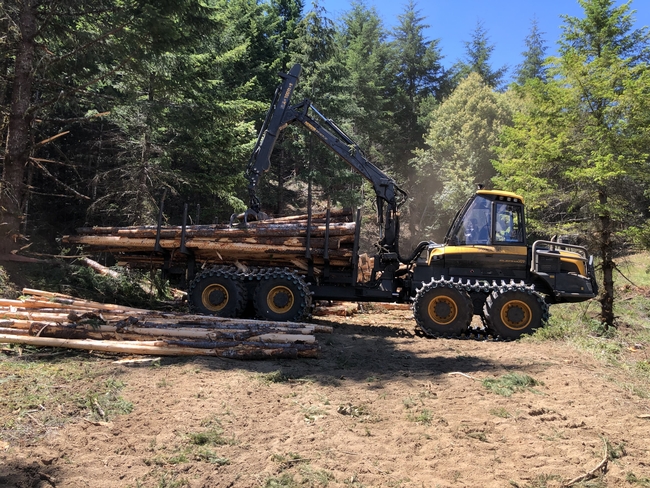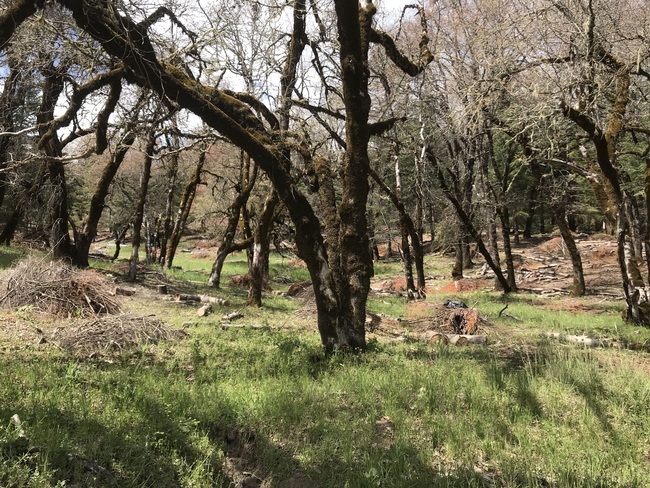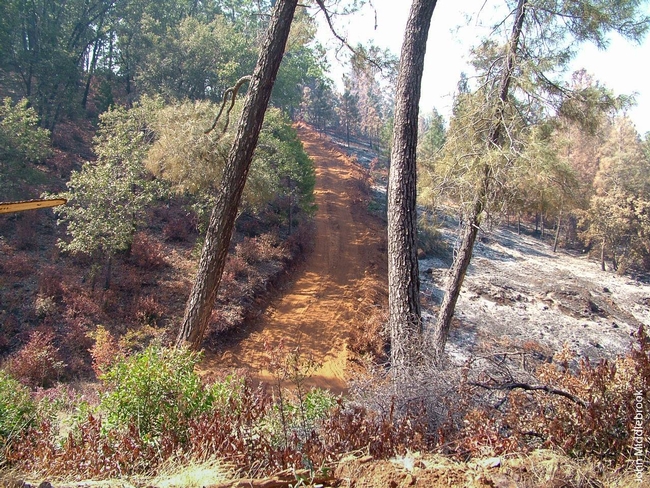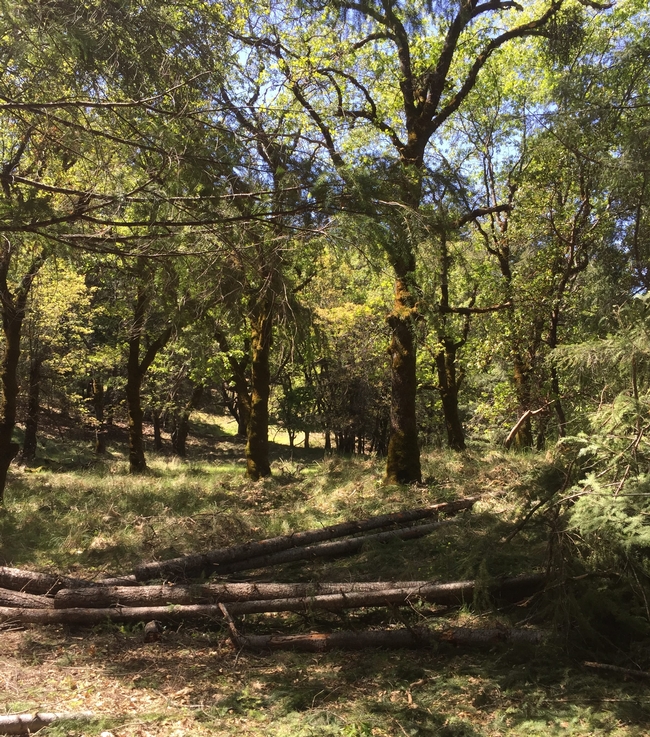Posts Tagged: fuel
Free wildfire publication simplifies understanding fuel-reduction permits on private land
UCCE forest advisor helps landowners, community groups determine best project options
As Californians prepare for another year of drought and an anticipated intense fire season, landowners and organizations across California have been working to reduce forest fuels – flammable woody material – that can endanger their properties and communities.
For many of them, however, their urgent efforts hit a sizable speed bump: a massive rulebook that describes, amid a thicket of other information, the permits required before people can treat or remove fuels – as well as a litany of attached requirements, restrictions and stipulations.
“The California Forest Practice Rules are 410 pages, in font size 6,” said Yana Valachovic, UC Cooperative Extension forest advisor for Humboldt and Del Norte counties and registered professional forester. “Trying to figure out what permit vehicles make sense in the rulebook is not easy even for the experienced professional forester.”
To assist private landowners and community groups in deciphering the rules and determining their most cost-effective options, Valachovic took the lead in writing a new guide, “Planning and Permitting Forest Fuel-Reduction Projects on Private Lands in California,” available as a free resource in the UC Agriculture and Natural Resources catalog.
“We tried to create a system where all the permits are laid out side-by-side, and put in a decision tree framework to help make it easier,” said Valachovic, highlighting the publication's tables that break down the project goals and parameters a permit applicant should think about when weighing their choices.
Considerations include whether the project is pre- or post-wildfire, the location and dimensions of trees targeted for removal, the conditions of the site before and after the project, potential time limits, commercial options, and, crucially, budget constraints – given that the permitting process could comprise up to one-third of total project costs.
A primer for planning and preparation
Chris Curtis, the unit forester for CAL FIRE's Humboldt-Del Norte Unit, said that he and his colleagues are grateful for this new tool and plan to use it as an “over the counter” handout for community members. He added that the charts summarizing timber-harvesting regulations and possible funding sources are especially helpful.

The publication helps prepare the landowner or community entity (such as Resource Conservation Districts, Fire Safe Councils or other concerned groups) for the types of questions that might come up in preliminary planning conversations with a registered professional forester or RPF.
Just as a homeowner would talk with a contractor before tackling a construction project, landowners and community groups must consult with an RPF, Valachovic said. RPFs have the specialized knowledge of forest practice rules and regulations related to water, air quality and endangered species protections, and the license to file the permitting documents.
“That's what I do in my job: Landowners come to me and we start talking about goals and objectives,” she said. “We start thinking about potential timelines – which goals are short-term, which are long-term – and how we can put an operational plan together to help those landowners achieve their goals.”
Long-term projects, short-term actions
Among the many practical tips outlined in this guide, Valachovic emphasized one in particular: for landowners dipping their toes into fuel reduction for the first time, keep the project “simple and realistic.”

In the short-term, however, Valachovic stressed that the extremely dry conditions across the state make it imperative for Californians to harden their homes, manage the fuels (i.e., landscape plants, stored wood, tall grass, etc.) immediately adjacent to their homes, and devise and review family emergency plans; see UC ANR's Wildfire Preparation page for detailed information and resources.
“There are a lot of immediate actions that people can be doing this year to help mitigate their wildfire risks and prepare for the unexpected,” she said.
In addition to Valachovic, co-authors of “Planning and Permitting Forest Fuel-Reduction Projects on Private Lands in California” are Jared Gerstein of BBW Associates and Brita Goldstein, UCCE staff research associate in Humboldt and Del Norte counties; both are registered professional foresters.
Federal government proposes new fuel breaks to manage wildfire
The Federal Government has proposed spending $55 to $192 million to clear large swaths of land in the Western U.S. to create fuel breaks that slow the spread of wildfire, reported Brady McCombs of the Associated Press. The fuel breaks will be managed by the Bureau of Land Management in Idaho, Oregon, Washington, California, Nevada and Utah.
Fuel breaks are a useful tool if used along with other wildfire prevention methods that can keep firefighters safer and potentially help out in broad scopes of land because they are long and thin, said Lenya Quinn-Davidson, the area fire advisor for University of California Cooperative Extension. They can be especially helpful by providing perimeters for prescribed burns. But they must be in the right places, she said.
The article said the BLM has done about 1,200 assessments of fuel breaks since 2002 and found they help control fires about 80 percent of the time. The new fuel breaks will be 500 feet wide or less and created along highways, rural roads and other areas already disturbed.
Forest fuel breaks lived up to their billing

UC ANR Cooperative Extension hosted the tour to bring together the different agencies that can collaborate fighting fires, managing forests and building and maintaining fuel breaks to arrest the spread of wildfire.
"Part of the reason (Old Station) didn't burn down is because of all the fuel breaks that the Forest Service had implemented around that general area," said UC ANR Cooperative Extension forestry advisor Ryan DeSantis. "The majority of fires we see are impeded by fuel breaks. They give firefighters time and safer places to fight fires."
Tour participants also discussed maintenance of current fuel breaks, both with and without herbicides. One issue is lack of funding.
"It's good to have everyone come to the table, all the different organizations all the different agencies and get together to discuss what the issues are and how to get through them," DeSantis said.
High gas prices won't drive up food prices

The cost of fuel is only a small percentage of the cost of farming and getting a product to store shelves, said Daniel Sumner, UC Cooperative Extension specialist in the Department of Agricultural and Resource Economics at UC Davis. Food prices will go up only by a few pennies on the dollar at most.
The small increase in cost, however, won't trickle down to growers.
"We farmers don't have any way to recoup the higher gas costs or pass them on to consumers, so we have to swallow them," said Fresno County farmer Keith Nilmeier, who grows apricots, peaches, nectarines, grapes and oranges.
Kaffka, partners awarded $2 million to develop biofuel

Biodiesel Industries has partnered with Stephen Kaffka, director of the California Biomass Collaborative and UC Cooperative Extension specialist in the Department of Plant Sciences at UC Davis.
Kaffka will conduct research to develop viable biofuel feedstocks at test plots at UC Davis and in Salinas, the Imperial Valley and Five Points in the Central Valley, according to the article.
Biodico President Russell Teall said, "The goal is to develop innovative solar cogeneration, anaerobic digestion and gasification. While Dr. Kaffka will look at the agronomics, Diener will take those results and use them in a larger context. We will be able to take biomass, which can be gasified and used to make heat and power that will provide a very clean form of combustion."
Teall said the project should start in June, with various equipment in place by August or September.


